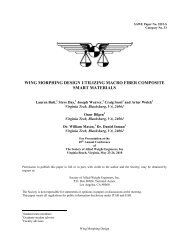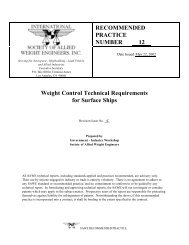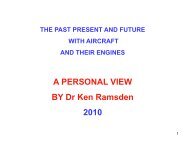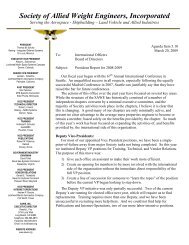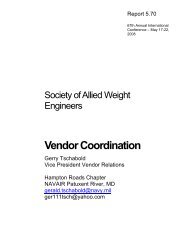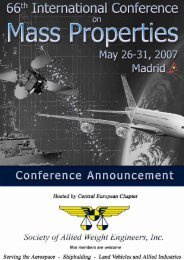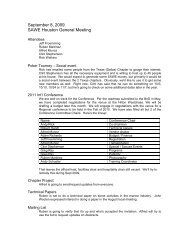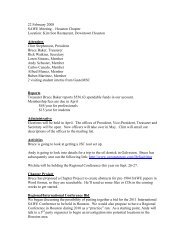Mass Properties - Society of Allied Weight Engineers
Mass Properties - Society of Allied Weight Engineers
Mass Properties - Society of Allied Weight Engineers
Create successful ePaper yourself
Turn your PDF publications into a flip-book with our unique Google optimized e-Paper software.
Aircraft <strong>Weight</strong> Estimating and use <strong>of</strong> SAWE RP-08: <strong>Weight</strong> and Balance Reporting Forms for Military<br />
Aircraft<br />
Dudley Cate, SAWE Fellow, NAVAIR-Retired<br />
The objectives <strong>of</strong> this one-day course are to provide an overview <strong>of</strong> weight estimating methods and<br />
the weight estimating process for aircraft and to provide insight into the weight and balance reporting<br />
formats and requirements <strong>of</strong> SAWE Recommended Practice 8. Included will be descriptions <strong>of</strong> the many<br />
types <strong>of</strong> aircraft estimating methods, together with their applicability and limitations. Many other weight<br />
estimating considerations also will be addressed, including impacts <strong>of</strong> new technologies, estimating<br />
prototypes and derivatives, sources <strong>of</strong> weight data and estimating methods, and dealing with estimating<br />
uncertainty. Estimating aircraft center <strong>of</strong> gravity location and moments <strong>of</strong> inertia will be briefly discussed.<br />
The portion <strong>of</strong> the course devoted to RP-08 will address the three major parts contained therein. The<br />
basic RP-08 concept <strong>of</strong> allocation by function will be explained, and the important RP-08 allocation<br />
instructions will be covered. The requirements for structural increments and design information also<br />
will be addressed, along with why inclusion <strong>of</strong> those data is so important to weight estimating and<br />
weight control.<br />
Principles <strong>of</strong> <strong>Weight</strong> Management and <strong>Weight</strong> Estimating Methods for the Offshore Oil Industry<br />
Andy Schuster, SBM Offshore, SAWE Honorary Fellow<br />
<strong>Weight</strong> Management is a critical element <strong>of</strong> design, construction, and operation <strong>of</strong> an <strong>of</strong>fshore oil system.<br />
Keeping the weight and center <strong>of</strong> gravity within predefined limits can be challenging. However, application<br />
<strong>of</strong> proven principles and tools will result in achieving these goals.<br />
The principles involved in weight management for the <strong>of</strong>fshore oil industry will be presented and<br />
explained. The student will develop an understanding <strong>of</strong> technical topics such as development <strong>of</strong><br />
preliminary and detailed weight estimates, application <strong>of</strong> weight contingencies and allowances to cover<br />
‘known unknowns,’ control <strong>of</strong> changes to designs, and weight saving techniques. The student will<br />
develop an appreciation <strong>of</strong> how weight information is used by other project team members such as cost<br />
control, scheduling, transport and lift contractors, and others. Also, the student will learn about some<br />
<strong>of</strong> the techniques that can be used to successfully manage the weight.<br />
A key to <strong>Weight</strong> Management is the initial weight estimate. Therefore, an overview <strong>of</strong> weight estimating<br />
methods as defined in SAWE RP-14 and applied to the <strong>of</strong>fshore industry is included. For example<br />
the application <strong>of</strong> proven methods - based on historical weight data and experience - is employed to<br />
determine preliminary weights for <strong>of</strong>fshore structures.<br />
This training course will highlight the importance <strong>of</strong> weight management in the oil industry, present<br />
several <strong>of</strong> the methods typically used to create preliminary estimates <strong>of</strong> weight and center <strong>of</strong> gravity<br />
and walk through an example <strong>of</strong> estimating preliminary weight and CG data for a floating <strong>of</strong>fshore<br />
platform. This class was jointly taught and developed by Andy Schuster (SBM Offshore) and Dave<br />
Bennett (WorleyParsons) for the 2011 International Conference in Houston, Texas, as two half day<br />
classes. It is being <strong>of</strong>fered in 2012 in a full day to better serve the SAWE membership.<br />
Aircraft <strong>Weight</strong> & Balance Course<br />
Tom Oole, SAWE Honorary Fellow, United States Air Force - Retired<br />
This two-day course assumes a basic knowledge <strong>of</strong> weight and balance. The class will demonstrate and<br />
teach proper procedures for weighing and completing forms for military aircraft. The intent <strong>of</strong> this class<br />
is to provide the student with an understanding <strong>of</strong> the weight and balance system within the United<br />
States Air Force and “pitfalls” involved in weighing aircraft. Students should bring basic calculators,<br />
paper, and pens/pencils for use in examples and exercises. Students should also dress appropriately for<br />
the trip to the aircraft hangar. Wear rubber-soled, closed-toed shoes.<br />
©2012 SAWE – www.sawe.org 13<br />
Conference Announcement



